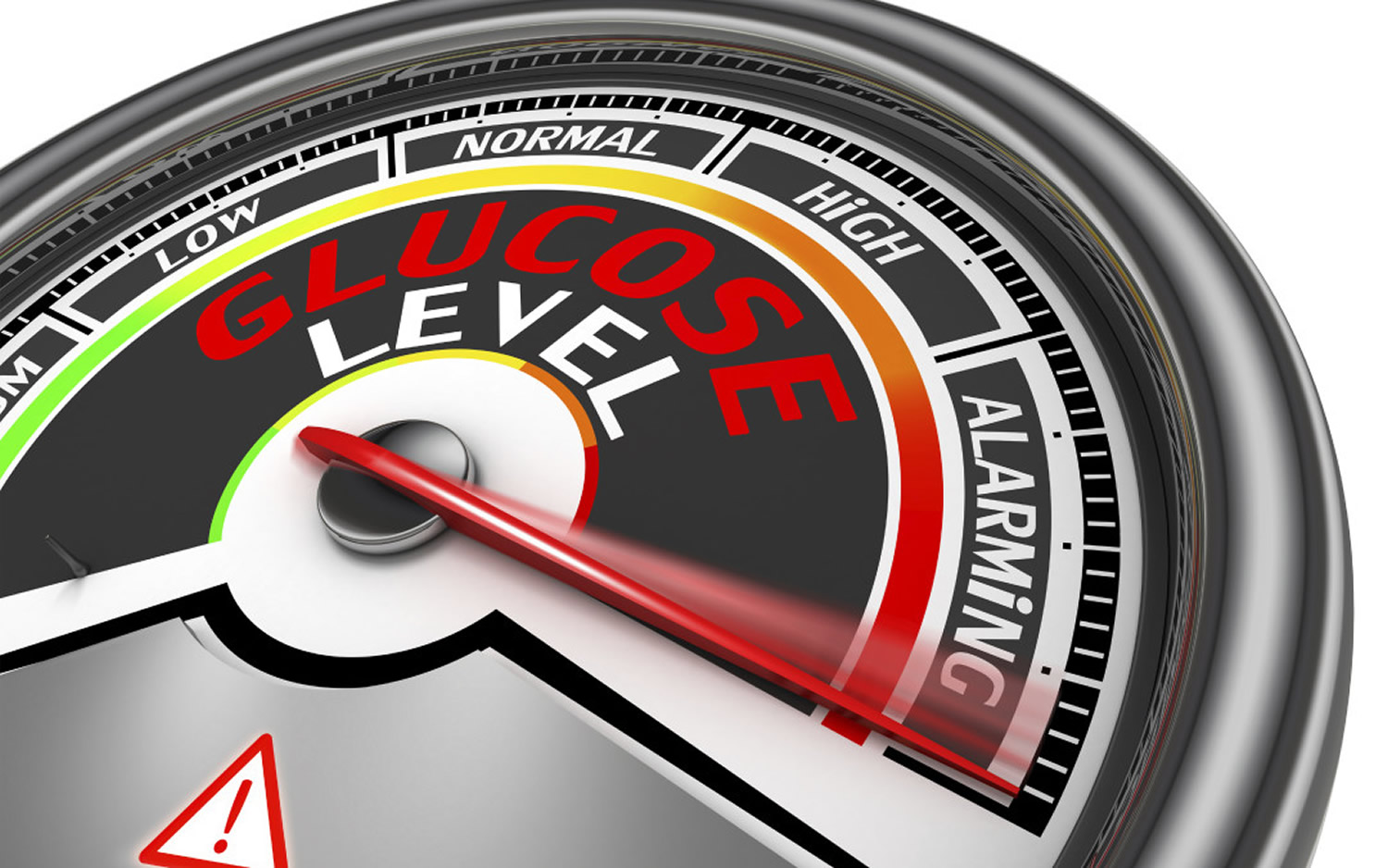
Hyperosmolar hyperglycemic state is a life-threatening emergency manifested by marked elevation of blood glucose and hyperosmolarity with little or no ketosis. Although there are multiple precipitating causes, underlying infections are the most common. Other causes include certain medications, nonadherence to therapy, undiagnosed diabetes mellitus, substance abuse, and coexisting disease. In children and adolescents, hyperosmolar hyperglycemic state is often present when type 2 diabetes is diagnosed. Physical findings include profound dehydration and neurologic symptoms ranging from lethargy to coma. Treatment begins with intensive monitoring of the patient and laboratory values, especially glucose, sodium, and potassium levels. Vigorous correction of dehydration is critical, requiring an average of 9 L of 0.9% saline over 48 hours in adults. After urine output is established, potassium replacement should begin. Once dehydration is partially corrected, adults should receive an initial bolus of 0.1 units of intravenous insulin per kg of body weight, followed by a continuous infusion of 0.1 units per kg per hour (or a continuous infusion of 0.14 units per kg per hour without an initial bolus) until the blood glucose level decreases below 300 mg per dL. In children and adolescents, dehydration should be corrected at a rate of no more than 3 mOsm per hour to avoid cerebral edema. Identification and treatment of underlying and precipitating causes are necessary.
SORT: KEY RECOMMENDATIONS FOR PRACTICE
| Clinical recommendation | Evidence rating | References |
|---|---|---|
| Fluid and electrolyte replacement should be initiated in patients with HHS based on recommendations from the American Diabetes Association (Figure 2). | C | 6 |
| Phosphate replacement should be considered in patients with HHS only if hypophosphatemia is severe (less than 1.0 mEq per L [1.0 mmol per L]) or if respiratory depression, anemia, or cardiac dysfunction is present. | C | 6 |
| Insulin therapy should be initiated in patients with HHS once fluid replacement has been started. | C | 6 |
| Patients should be assessed and treated for underlying causes of HHS. | C | 6 |
HHS = hyperosmolar hyperglycemic state.
A = consistent, good-quality patient-oriented evidence; B = inconsistent or limited-quality patient-oriented evidence; C = consensus, disease-oriented evidence, usual practice, expert opinion, or case series.
Comparison of Diabetic Ketoacidosis with Hyperosmolar Hyperglycemic State
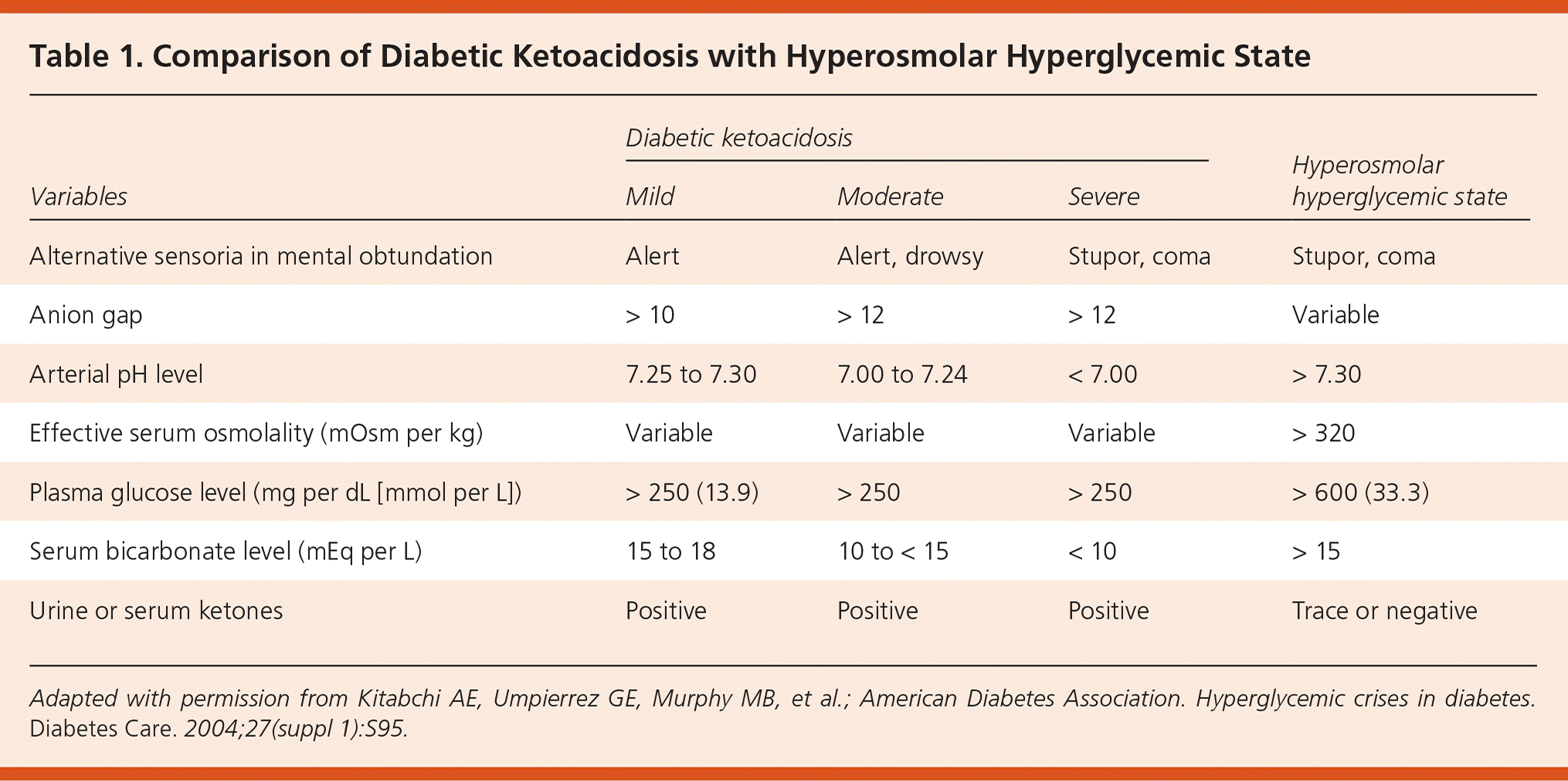
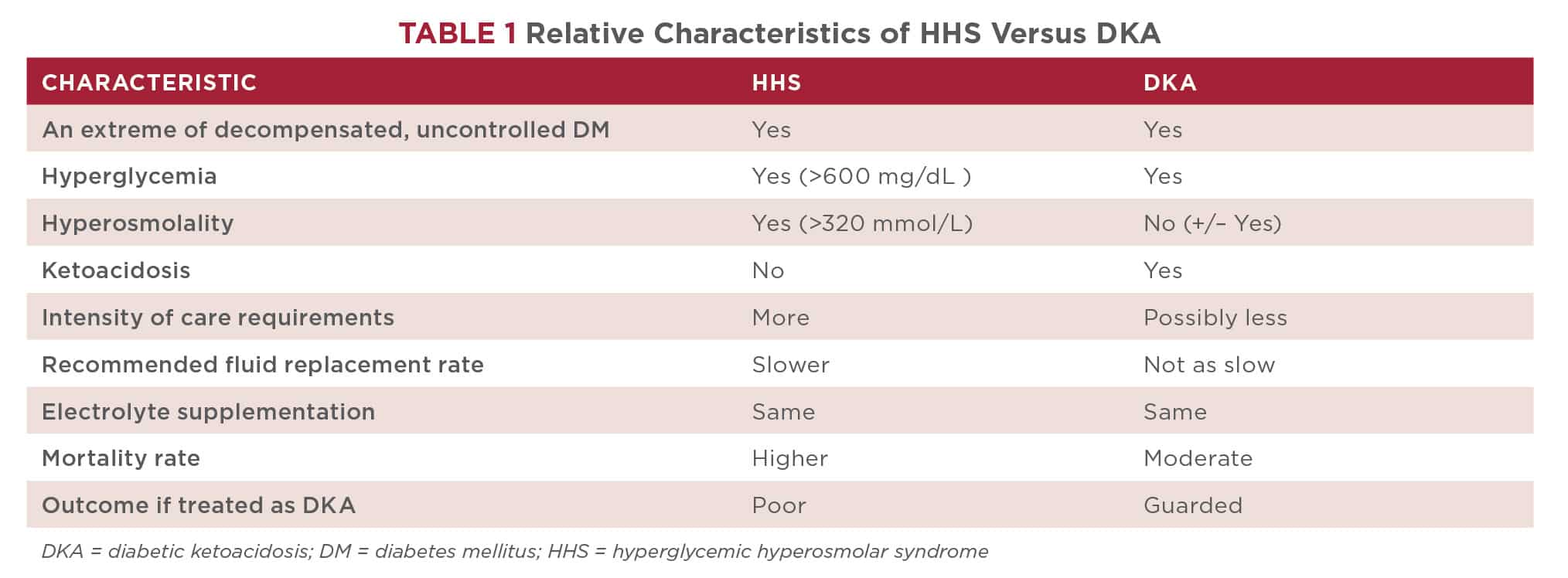
The mortality rate from HHS ranges from 10% to 50%, which is considerably higher than that of DKA (1.2% to 9%). In children, the mortality rate from HHS may be as high as 60%. Mortality predictors include age, degree of dehydration, hemodynamic instability (hypotension, absence of reflex tachycardia), degree of consciousness, infection, and a history of cancer.
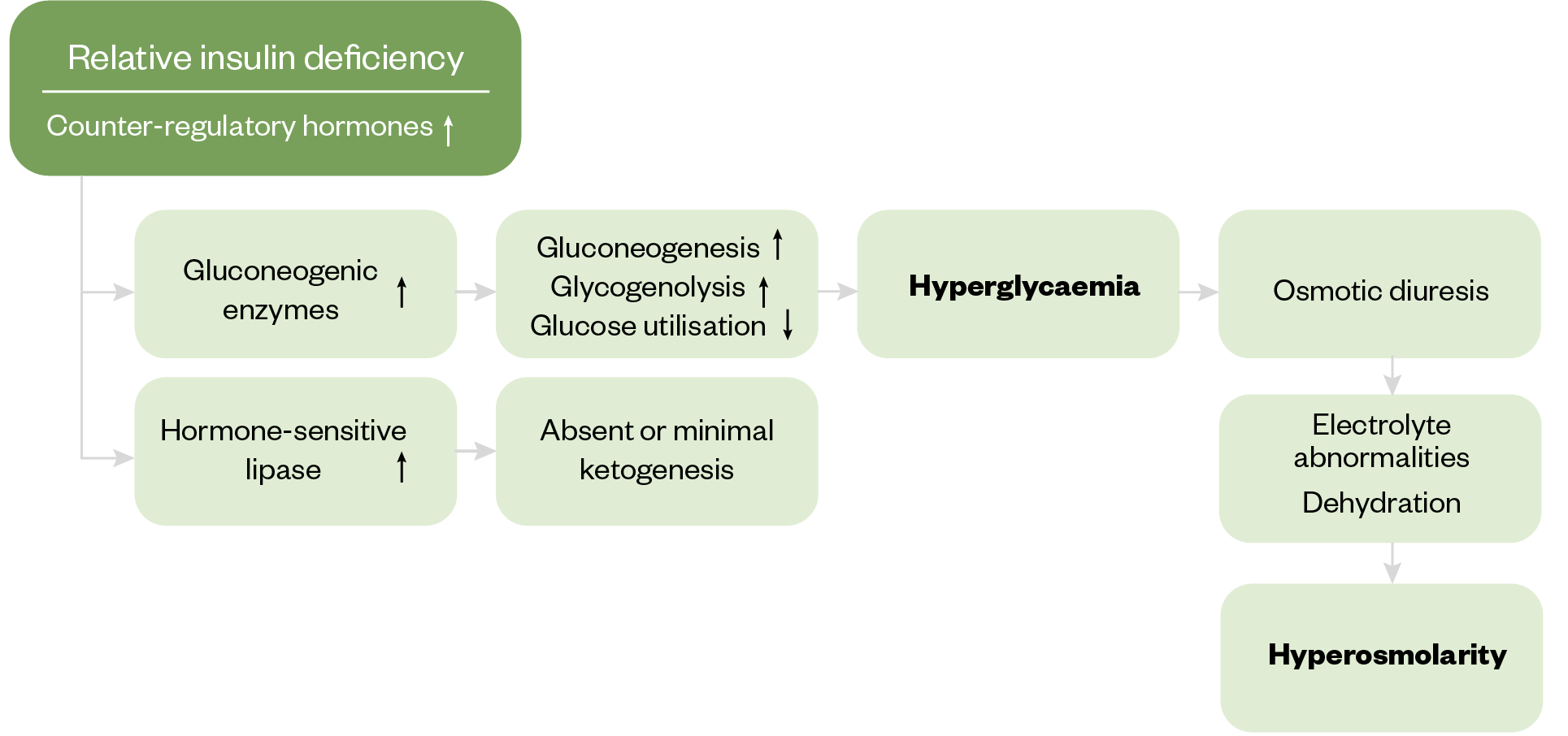
Pathophysiology
Elevated levels of counterregulatory hormones (glucagon, catecholamines, cortisol, and growth hormone) initiate HHS by stimulating hepatic glucose production through glycogenolysis and gluconeogenesis, leading to hyperglycemia, intracellular water depletion, and subsequent osmotic diuresis. High levels of catecholamines combined with low levels of insulin reduce peripheral glucose uptake. Glycosuria causes greater loss of water than of sodium, resulting in hyperosmolarity and dehydration. Decreased intravascular volume, often combined with underlying renal disease, decreases the glomerular filtration rate, thereby decreasing glucose clearance and further increasing blood glucose levels.
Although the insulin level is not adequate to control blood glucose, it can suppress lipolysis and ketogenesis. Proinflammatory cytokines (e.g., tumor necrosis factor α, interleukin β, interleukin-6, interleukin-8), plasminogen activator inhibitor-1, reactive oxygen species, and lipid peroxidation increase two- to threefold during the acute crisis, but return to normal within 24 hours. These increases create a temporary prothrombotic environment that increases the risk of vascular occlusion, mesenteric artery thrombosis, myocardial infarction, low-flow syndrome, disseminated intravascular coagulopathy, cerebrovascular accident, and bilateral femoral artery thrombosis.
Causes and Risk Factors
HHS can be precipitated by infections, medications, non-adherence to therapy, undiagnosed diabetes, substance abuse, and coexisting diseases (Table 2). Infections are the leading cause (57% of cases); pneumonia, often gram-negative, is the most common infection, followed by urinary tract infection and sepsis. Poor adherence to diabetes medication causes 21% of HHS cases. Other causes include myocardial infarction, cerebrovascular accident, pulmonary embolism, and mesenteric artery thrombosis. Psychoactive medications, especially second-generation antipsychotics, cause glucose elevations, insulin resistance, and diabetes independent of weight gain. Older adults with type 2 diabetes (sometimes undiagnosed) are at higher risk of HHS because they often take dehydrating medications (e.g., diuretics) and may be unable to adequately communicate their symptoms if they live alone or in a nursing home.
Precipitating Factors in Hyperosmolar Hyperglycemic State
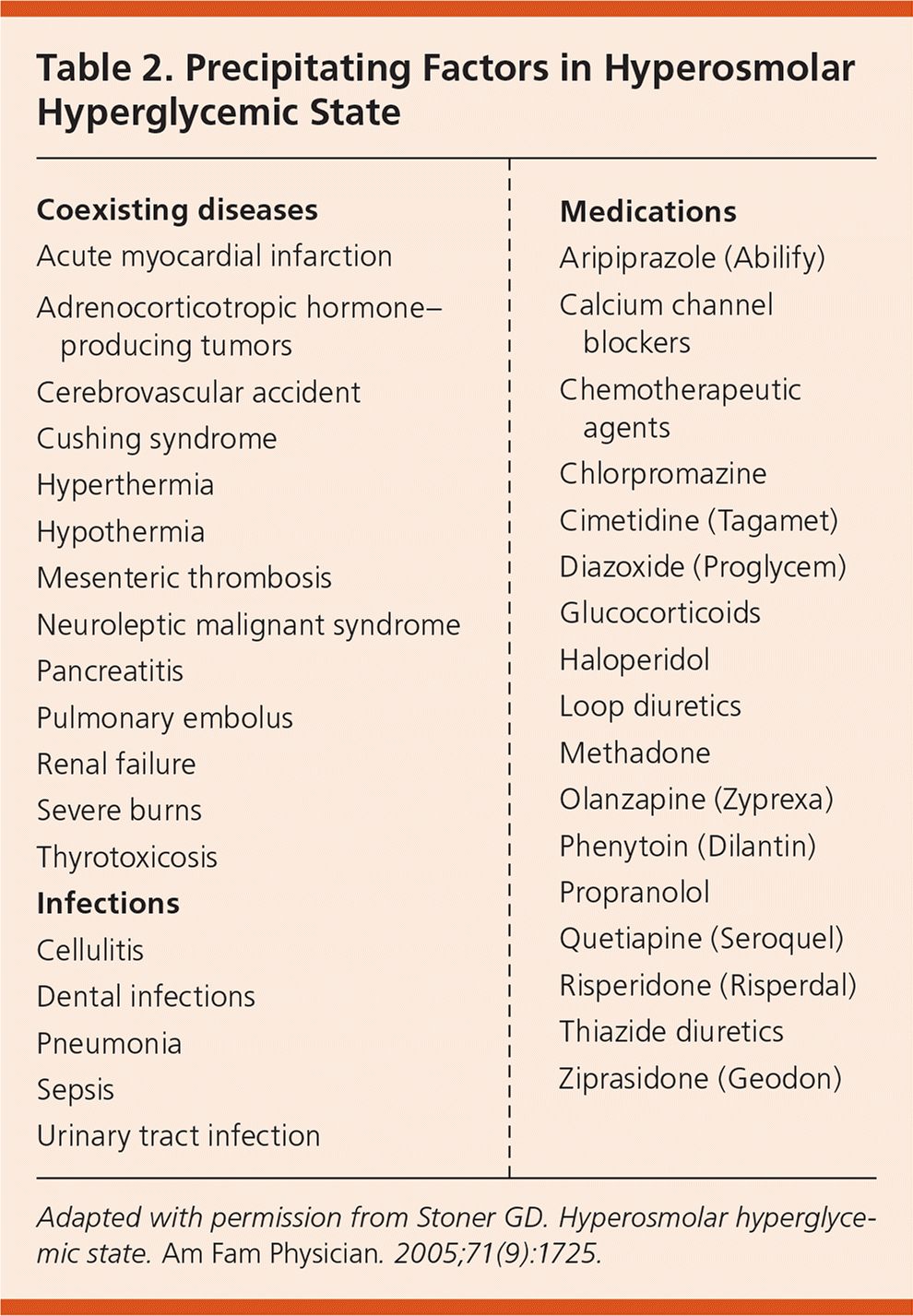
Adapted with permission from Stoner GD. Hyperosmolar hyperglycemic state. Am Fam Physician . 2005;71(9):1725.
Risk factors for HHS in children include morbid obesity (body mass index of 39 kg per m or greater), long-term steroid use, gastroenteritis, black race, acanthosis nigricans, and a family history of diabetes. Undiagnosed diabetes can result in HHS when early symptoms are unrecognized, particularly in children.
Clinical Presentation
Physical findings in patients with HHS include profound dehydration with poor tissue turgor; dry buccal mucosa; soft, sunken eyeballs; cool extremities; and a rapid, thready pulse. Adults often present with a low-grade fever. Children may present with nonspecific symptoms such as headache, weakness, and vomiting with or without abdominal pain. Abdominal distention may occur secondary to gastroparesis induced by hypertonicity. Abdominal distention that persists after rehydration may have another underlying cause and requires further investigation.
Depending on effective serum osmolarity, mental status can range from complete lucidity to disorientation and lethargy to coma. Coma often occurs once the serum osmolarity is greater than 340 mOsm per kg. Seizures occur in up to 25% of patients and may be generalized, focal, myoclonic jerking, or movement induced. Hemiparesis may occur but should resolve when the fluid deficit is corrected.
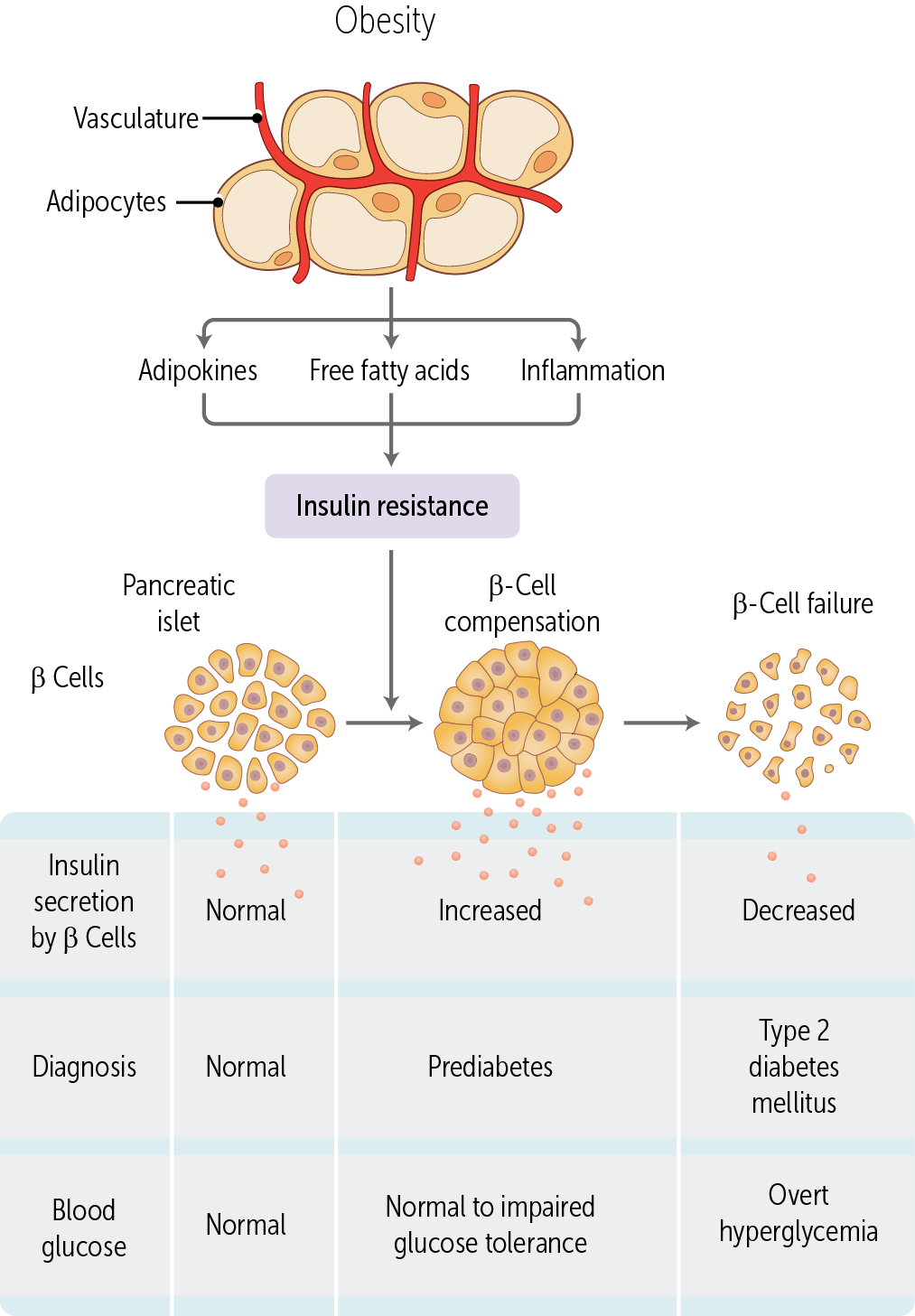
Clinical Presentation
Physical findings in patients with HHS include profound dehydration with poor tissue turgor; dry buccal mucosa; soft, sunken eyeballs; cool extremities; and a rapid, thready pulse. Adults often present with a low-grade fever. Children may present with nonspecific symptoms such as headache, weakness, and vomiting with or without abdominal pain. Abdominal distention may occur secondary to gastroparesis induced by hypertonicity. Abdominal distention that persists after rehydration may have another underlying cause and requires further investigation.
Depending on effective serum osmolarity, mental status can range from complete lucidity to disorientation and lethargy to coma. Coma often occurs once the serum osmolarity is greater than 340 mOsm per kg. Seizures occur in up to 25% of patients and may be generalized, focal, myoclonic jerking, or movement induced. Hemiparesis may occur but should resolve when the fluid deficit is corrected.
COMPLICATIONS
Rhabdomyolysis, which is diagnosed by a serum creatine phosphokinase level more than 10 times the upper limit of normal, may increase the risk of acute renal failure. Children may experience a malignant hyperthermia-like syndrome that presents with high fever (often higher than 104°F [40°C]) and an elevated creatine kinase level. This syndrome may be caused by a reaction to m-cresol (a preservative in all preparations of regular insulin produced in the United States) and is treated with dantrolene (Dantrium).
Diagnostic Testing
Initial laboratory findings in patients with HHS include marked elevations in blood glucose levels (greater than 600 mg per dL [33.3 mmol per L]) and in serum osmolarity (greater than 320 mOsm per L of water [normal = 290 ± 5]), with a pH level greater than 7.30 and mild or absent ketosis. One-half of patients will have a mild anion-gap metabolic acidosis (i.e., 10 to 12). If the anion gap is greater than 12, the differential diagnosis should include lactic acidosis or, if the lactic acid level is not elevated, a combination of DKA and HHS or other entities unrelated to HHS. Vomiting and thiazide diuretics may cause a metabolic alkalosis that could mask the severity of acidosis. Serum potassium levels may be elevated or normal. Creatinine, blood urea nitrogen, and hematocrit levels are almost always elevated. HHS also produces significant total body losses of many electrolytes
Typical Water and Electrolyte Losses in Hyperosmolar Hyperglycemic State

The reported sodium level should be corrected when the patient’s glucose level is markedly elevated. The types of fluids administered depend on the corrected serum sodium level and the effective serum osmolality, which are calculated using the formulas in Figure 1.
Calculating corrected serum sodium and effective serum osmolality.
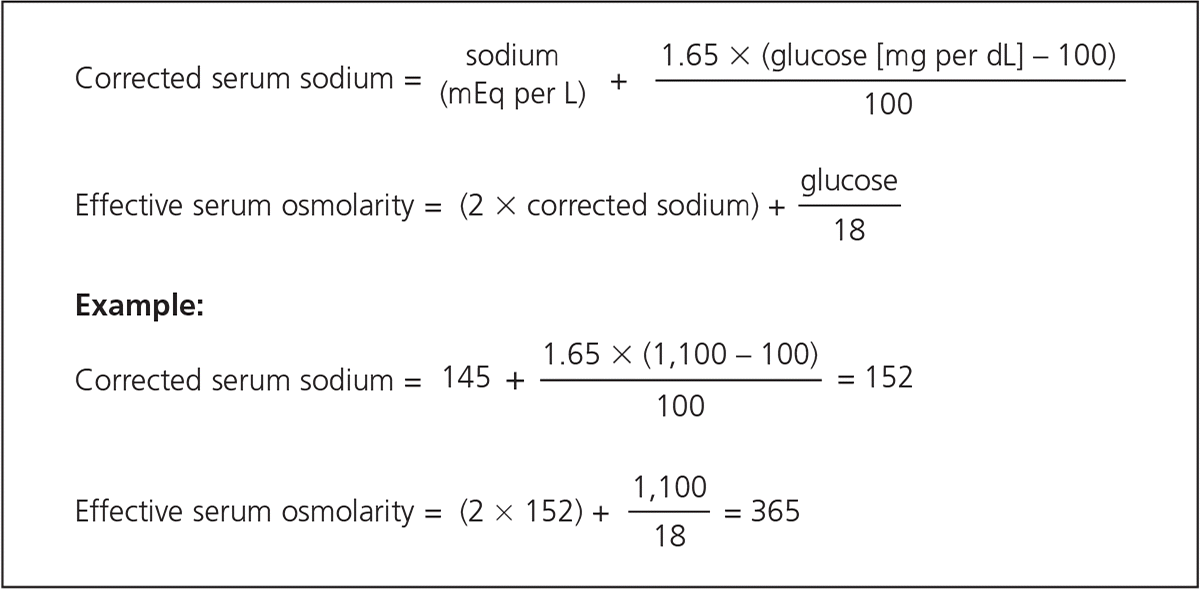
Treatment
Treatment of HHS requires a four-pronged approach:
(1) vigorous intravenous rehydration,
(2) electrolyte management,
(3) intravenous insulin, and
(4) diagnosis and management of precipitating and coexisting problems.
Figure 2 outlines the American Diabetes Association’s algorithm for managing DKA and HHS in adults. Patients require intensive care if they have cardiovascular instability, cannot maintain an airway, are obtunded, report acute abdominal symptoms, or cannot be monitored adequately on the general medical ward. Management of HHS in children is similar to that in adults.

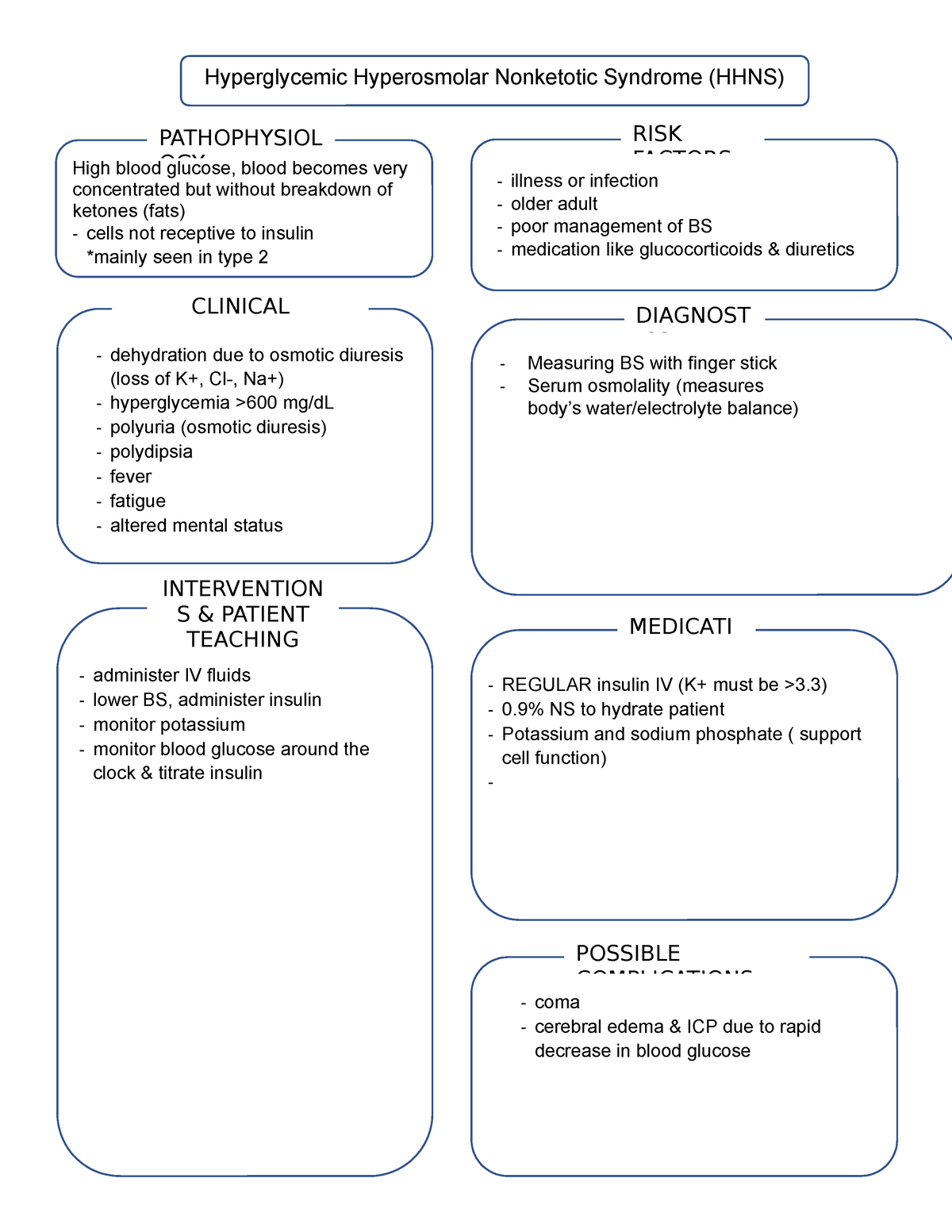
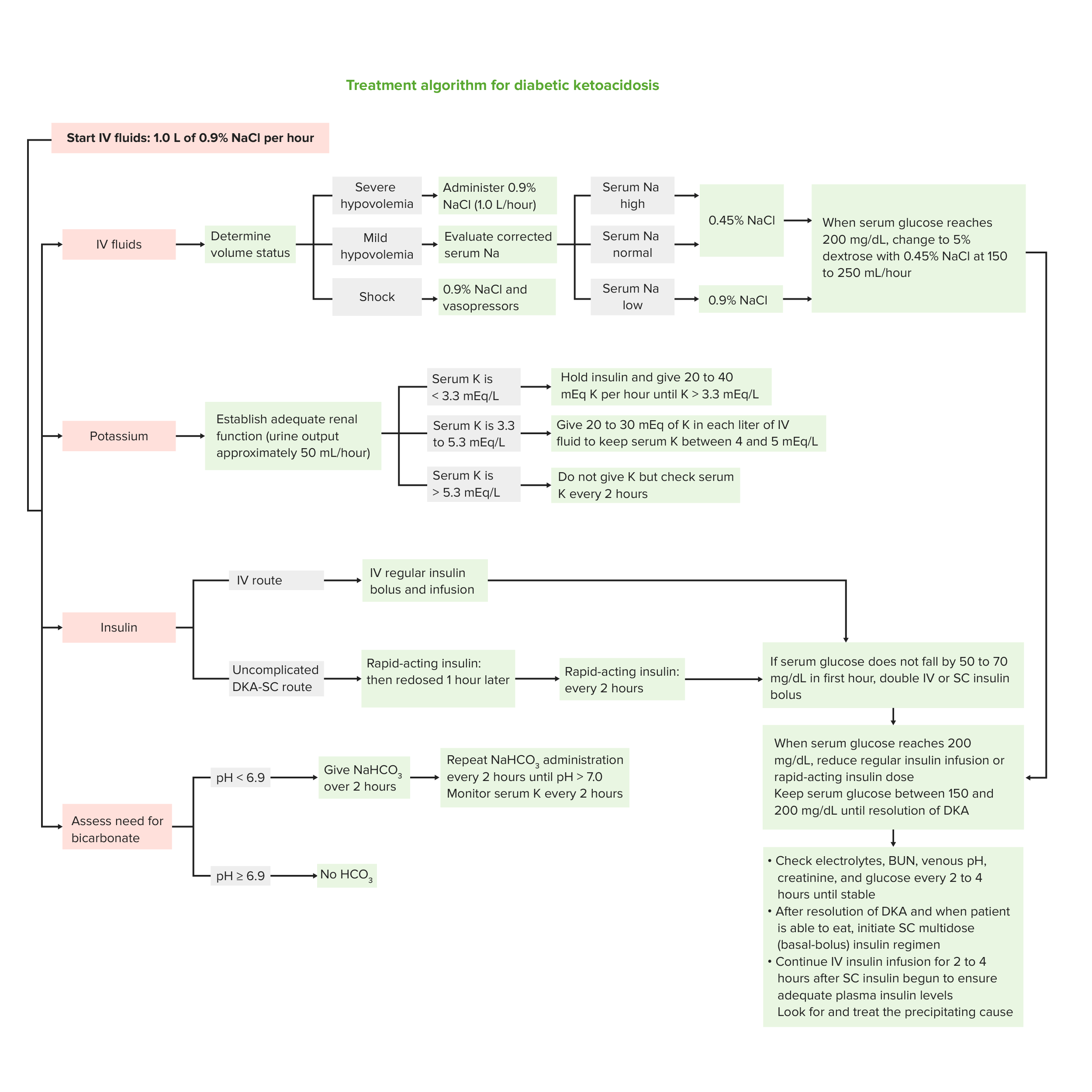
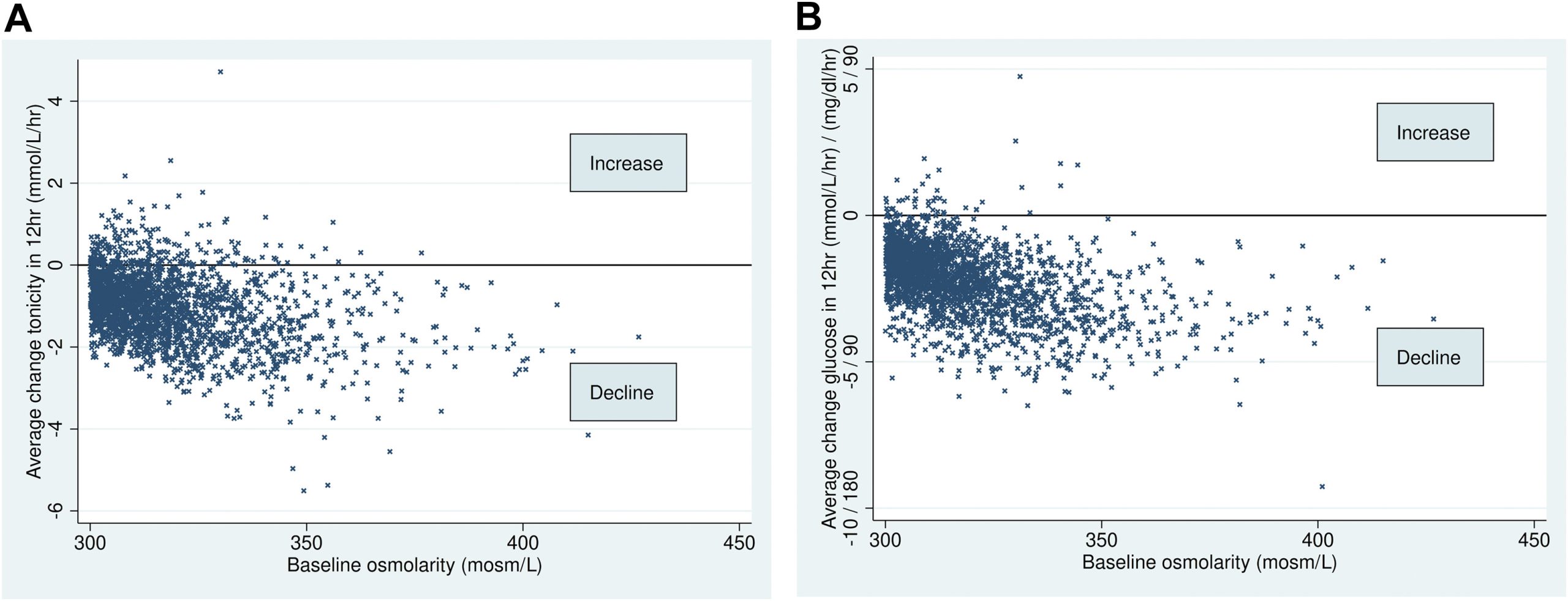
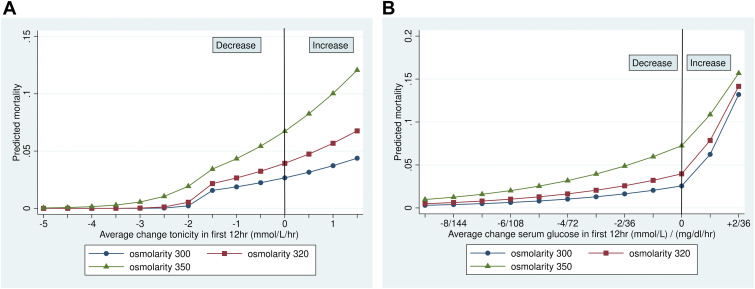
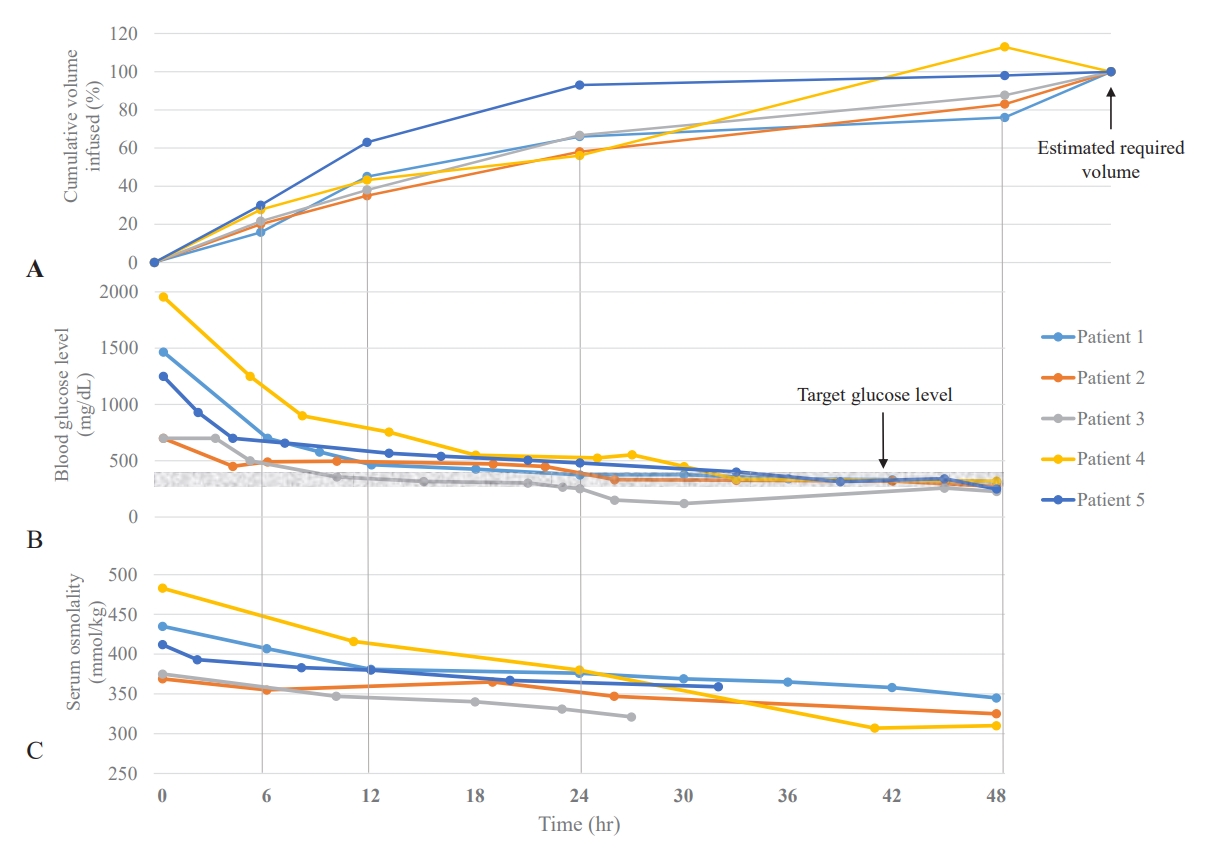
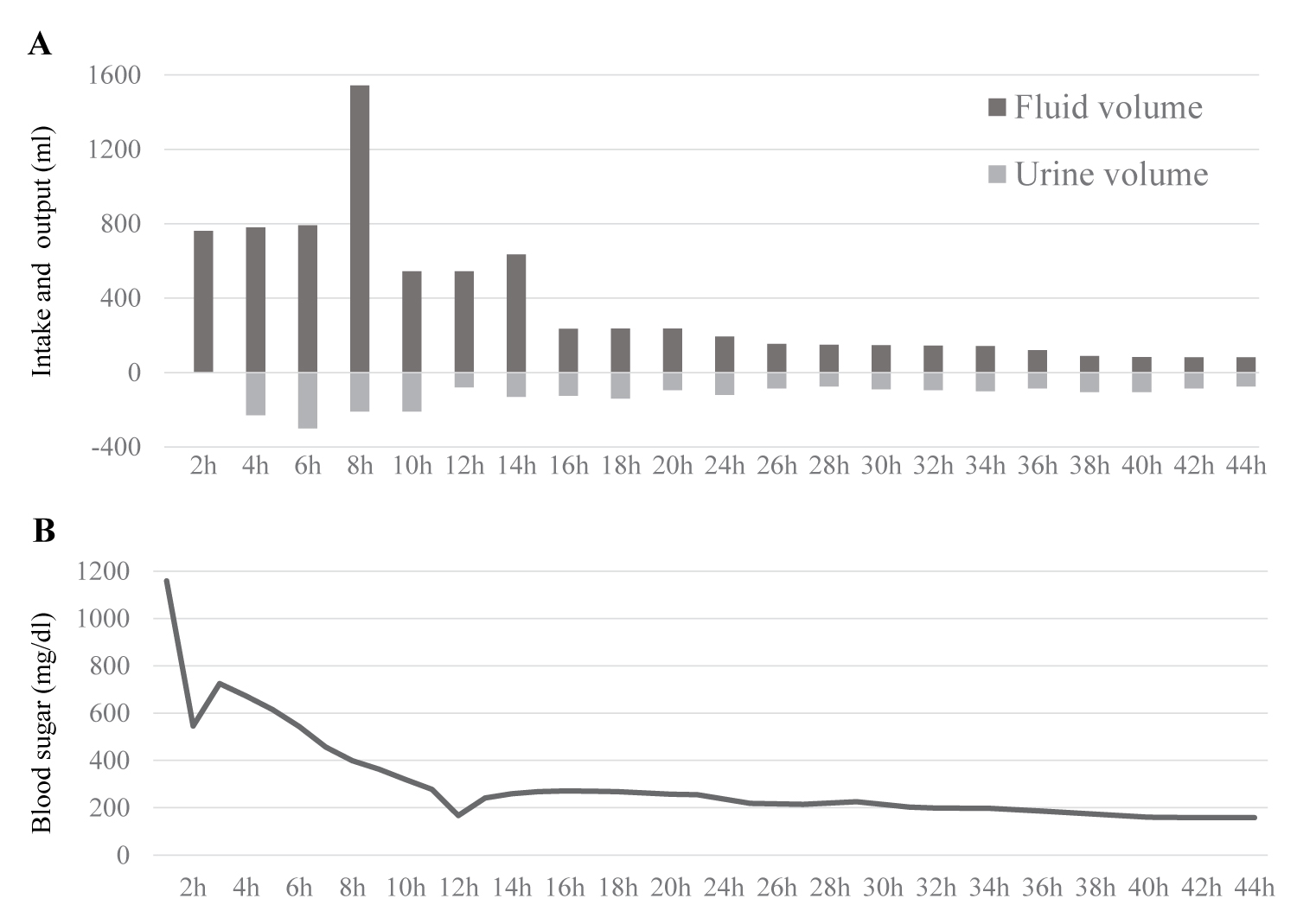
Management of DKA and HHS
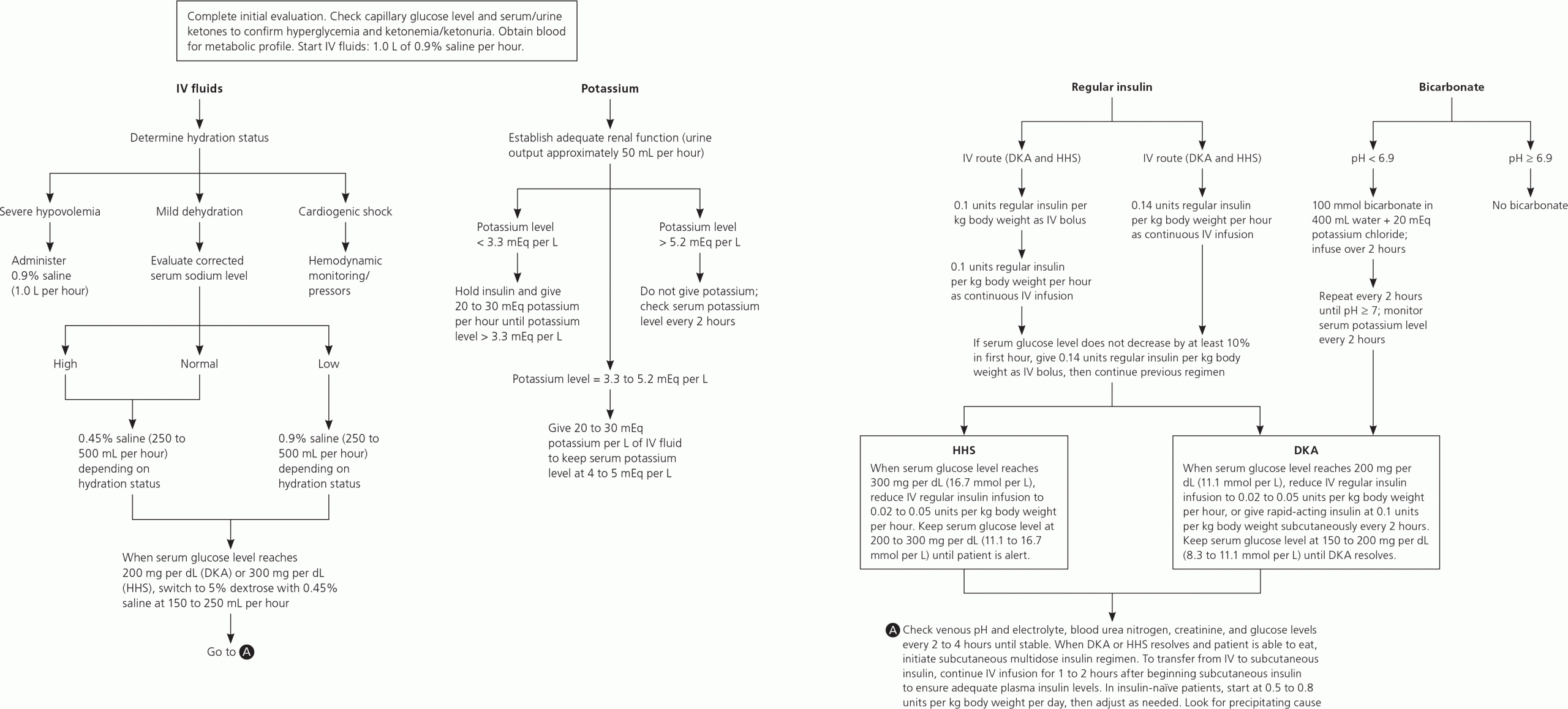
Algorithm for management of diabetic ketoacidosis (DKA) and hyperosmolar hyperglycemic state (HHS) in adults. Diagnostic criteria for DKA include blood glucose level of 250 mg per dL (13.9 mmol per L), arterial pH of 7.3, bicarbonate level of 15 mEq per L, and moderate ketonuria or ketonemia. (IV = intravenous.)
Adapted with permission from Kitabchi AE, Umpierrez GE, Miles JM, Fisher JN. Hyperglycemic crises in adult patients with diabetes. Diabetes Care. 2009;32(7):1339.



